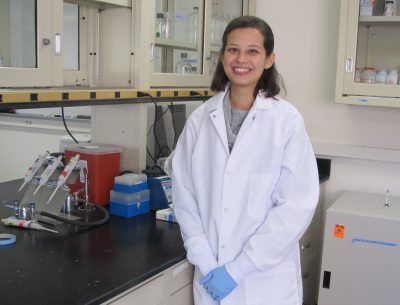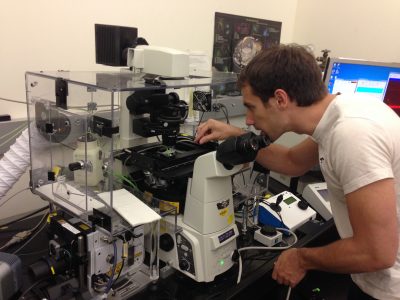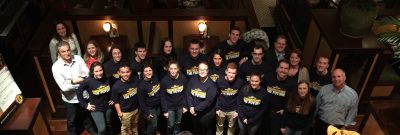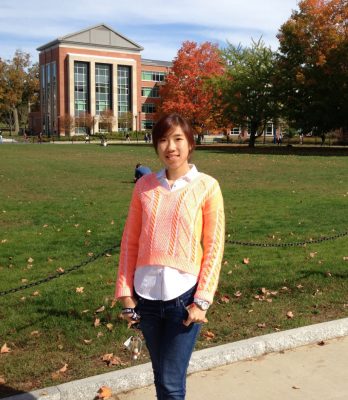 What happens when you mix UConn’s renowned Creamery and its top-notch Chemical Engineering department? If things go right, you get an ice cream that forgoes traditional sugar, but still earns a place along with the famously delicious ice creams at the Dairy Bar.
What happens when you mix UConn’s renowned Creamery and its top-notch Chemical Engineering department? If things go right, you get an ice cream that forgoes traditional sugar, but still earns a place along with the famously delicious ice creams at the Dairy Bar.
That’s the goal of two student teams working toward Senior Design Day. That event, May 1, is when students in the School of Engineering present their work toward solving a particular problem. Both teams are working with advisor Anson Ma, assistant professor in the Department of Chemical and Biomolecular Engineering and the Institute of Materials Science.
 One of the teams met on a recent morning at the UConn Department of Animal Science Creamery in the George White Building. This is where UConn’s ice cream is produced and later sold at the Dairy Bar next door. Bill Sciturro, manager of dairy manufacturing in the Department of Animal Science, helped the team work the batch machine, which freezes the mixture into ice cream. The aptly named machine makes one batch at a time – no more than a half gallon – and is used for testing purposes. Once a new recipe meets Creamery standards, it goes into production and is made with the continuous machine, which operates on a minimum of 50 gallons.
One of the teams met on a recent morning at the UConn Department of Animal Science Creamery in the George White Building. This is where UConn’s ice cream is produced and later sold at the Dairy Bar next door. Bill Sciturro, manager of dairy manufacturing in the Department of Animal Science, helped the team work the batch machine, which freezes the mixture into ice cream. The aptly named machine makes one batch at a time – no more than a half gallon – and is used for testing purposes. Once a new recipe meets Creamery standards, it goes into production and is made with the continuous machine, which operates on a minimum of 50 gallons.
Instead of cane sugar, this team is using erythritol, a natural sweetener derived from corn. They did so after surveys indicated a demand on campus for ice cream with alternative natural sweeteners. Erythritol is up to 70 percent as sweet as table sugar and has almost no calories. Most ice cream companies would call this “sugar-free” for marketing purposes. The students call it “reduced-sugar” because they’re scientists, and they’re counting the sugar that already exists in the milk. Get rid of lactose, they say, and you’re working with a whole other set of circumstances.
 Ice cream’s semi-solid state is the result of a fragile balance of ingredients, and it’s no easy trick to replace old-fashioned sugar and still get the rich taste and texture that makes the Creamery’s ice cream so popular.
Ice cream’s semi-solid state is the result of a fragile balance of ingredients, and it’s no easy trick to replace old-fashioned sugar and still get the rich taste and texture that makes the Creamery’s ice cream so popular.
“It’s difficult to change the solids, because that changes the freezing point – and that determines the way it behaves as an ice cream,” said Nicholas Fleming, one of the three team members. Too many salts and carbohydrates, he said, and the freezing point becomes too high for conventional freezers. To get it right, the team did a lot of experiments and calculations with heat transfer and ice recrystallization to see how their product fared with the Creamery’s current storage practices.
Considering the complexities of ice cream’s makeup, Ma says he is impressed by the students’ achievements so far. “Both teams have applied what they have learned in their engineering classes to arrive at their final recipe, while being cognizant of the economic feasibility, environmental impact, health, and safety,” he says.
So why ice cream? Using examples from everyday life is one of the most effective ways to engage the younger generation and the general public in science, Ma says: “The ice cream project really satisfies my passions for education, research, and food simultaneously!”
 After finishing the first batch at the Creamery, the team handed out samples to a few observers. Even at the very non-ice cream hour of 9 a.m., it proved a tasty snack – smooth, creamy, and betraying no indication of a non-traditional sweetener. At least to the casual observer. The team members were glad that the erythritol left no chemical hints or after-taste, but they agreed that the batch could use more vanilla. Team member Anh Nguyen said his ice cream palette has become a good deal more discriminating since the start of the project: “I’m a lot more picky.”
After finishing the first batch at the Creamery, the team handed out samples to a few observers. Even at the very non-ice cream hour of 9 a.m., it proved a tasty snack – smooth, creamy, and betraying no indication of a non-traditional sweetener. At least to the casual observer. The team members were glad that the erythritol left no chemical hints or after-taste, but they agreed that the batch could use more vanilla. Team member Anh Nguyen said his ice cream palette has become a good deal more discriminating since the start of the project: “I’m a lot more picky.”
For the next batch, team member Leonora Yokubinas was a little more generous with the vanilla extract, which she poured from a gallon jug into a graduated cylinder. They reached a consensus after a second taste test: erythritol-based ice cream is just about consumer-ready.
Ma’s other student team is using Splenda – an artificial sweetener derived from sugar. Team members Ivan Nguyen, Christina Fenny, and Mason Gao say they chose Splenda because it is FDA-approved, and has fewer harmful side effects than other artificial sweeteners (such as aspartame and acesulfame potassium). It’s also 600 times sweeter than sugar, so they don’t need to use much. This also means that there is less solid content in the base composition, however, so large ice crystals can form and make for a less creamy texture.
To address this issue, the team is flash-freezing their mixture with liquid nitrogen. This, they say, allows for some flexibility with the ice cream’s base composition because it freezes the ice cream quickly enough to form extremely small ice crystals – the key to maintaining a smooth texture.
Sciturro is just as invested in these projects as the students; the Dairy Bar could use a low-sugar option. They haven’t offered one in the past, but there have been requests. Rarely do people go to an ice cream parlor specifically for a low-sugar treat, he says, but if someone with special dietary needs comes with their family then it’s great to have that option: “After all, who doesn’t know someone who has a need for low-sugar foods?”
 Graduate student Christine Endicott is a true UConn Husky. Although a Vermont native, she received her B.S. in Chemical Engineering at UConn in 2008. Now, she’s back and in the second year of her PhD studies. And more? She’s still a Gampel season ticket holder.
Graduate student Christine Endicott is a true UConn Husky. Although a Vermont native, she received her B.S. in Chemical Engineering at UConn in 2008. Now, she’s back and in the second year of her PhD studies. And more? She’s still a Gampel season ticket holder.


 he United States remains the top graduate destination in the world. With superior quality and flexibility in its programs, UConn has everything the best programs have to offer and more. Third year PhD student Jie Qi stands by her decision to study Chemical Engineering here. “I chose UConn because of its strong reputation as a research University,” she says, “There are many great opportunities available to students including different internships, various options for financial aid, and a great network of alumni.”
he United States remains the top graduate destination in the world. With superior quality and flexibility in its programs, UConn has everything the best programs have to offer and more. Third year PhD student Jie Qi stands by her decision to study Chemical Engineering here. “I chose UConn because of its strong reputation as a research University,” she says, “There are many great opportunities available to students including different internships, various options for financial aid, and a great network of alumni.”
 Graduate students have many reasons to choose UConn, from conducting research in world class facilities, to a welcoming learning environment, and no shortage of school pride (not everyone wins dual National Championships in basketball).
Graduate students have many reasons to choose UConn, from conducting research in world class facilities, to a welcoming learning environment, and no shortage of school pride (not everyone wins dual National Championships in basketball). David’s faculty advisor is
David’s faculty advisor is  For the third consecutive summer, UConn’s Chemical & Biomolecular Engineering (CBE) Department hosed an NSF sponsored
For the third consecutive summer, UConn’s Chemical & Biomolecular Engineering (CBE) Department hosed an NSF sponsored  Instruments), High-Performance Nanostructured Organic/Inorganic Hybrids for Functional Applications (Nanocor), Development of Scalable Droplet Microfluidic Devices (BASF), Increasing Soil Water Retention with Bacteria (DuPont), Characterization of TiO2 Thin Films on 316L Stainless Steel Formed using a Sol-Gel Technique (VeruTEK Technologies), Plasmonic Nanodevices for Solar Energy Harvesting (Scitech Solar), and Sustainable Biofuels Production (RPM Sustainable Technologies).
Instruments), High-Performance Nanostructured Organic/Inorganic Hybrids for Functional Applications (Nanocor), Development of Scalable Droplet Microfluidic Devices (BASF), Increasing Soil Water Retention with Bacteria (DuPont), Characterization of TiO2 Thin Films on 316L Stainless Steel Formed using a Sol-Gel Technique (VeruTEK Technologies), Plasmonic Nanodevices for Solar Energy Harvesting (Scitech Solar), and Sustainable Biofuels Production (RPM Sustainable Technologies). Students spent their summer in a world-class academic research laboratory with state-of-the art instrumentation. They also toured local incubator spaces, and participated in an Innovation Accelerator event at a local private incubator.
Students spent their summer in a world-class academic research laboratory with state-of-the art instrumentation. They also toured local incubator spaces, and participated in an Innovation Accelerator event at a local private incubator. The Chemical Engineering graduate program at UConn provides the opportunity for students to obtain a thorough understanding of the principles of chemical engineering and gain the practical skills needed to succeed in the workplace. Students have the chance to get involved in a number of useful research and teaching opportunities to better prepare for their future.
The Chemical Engineering graduate program at UConn provides the opportunity for students to obtain a thorough understanding of the principles of chemical engineering and gain the practical skills needed to succeed in the workplace. Students have the chance to get involved in a number of useful research and teaching opportunities to better prepare for their future.

